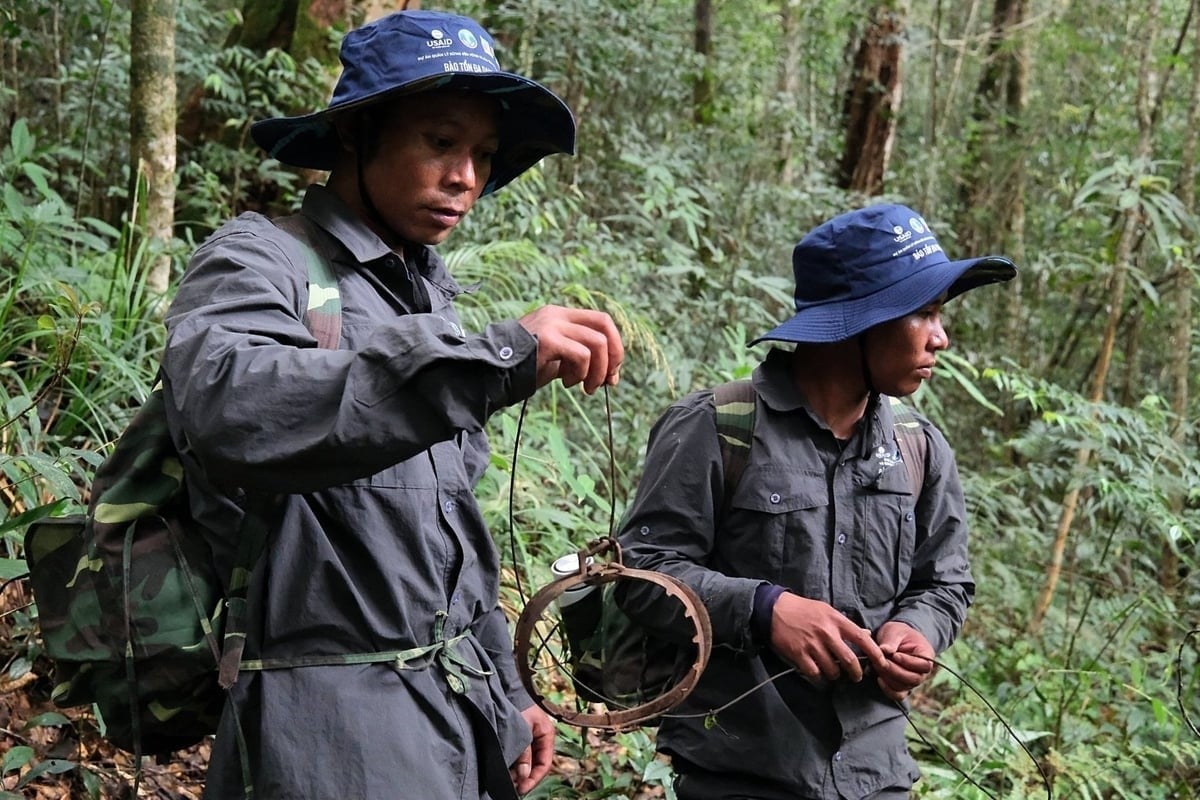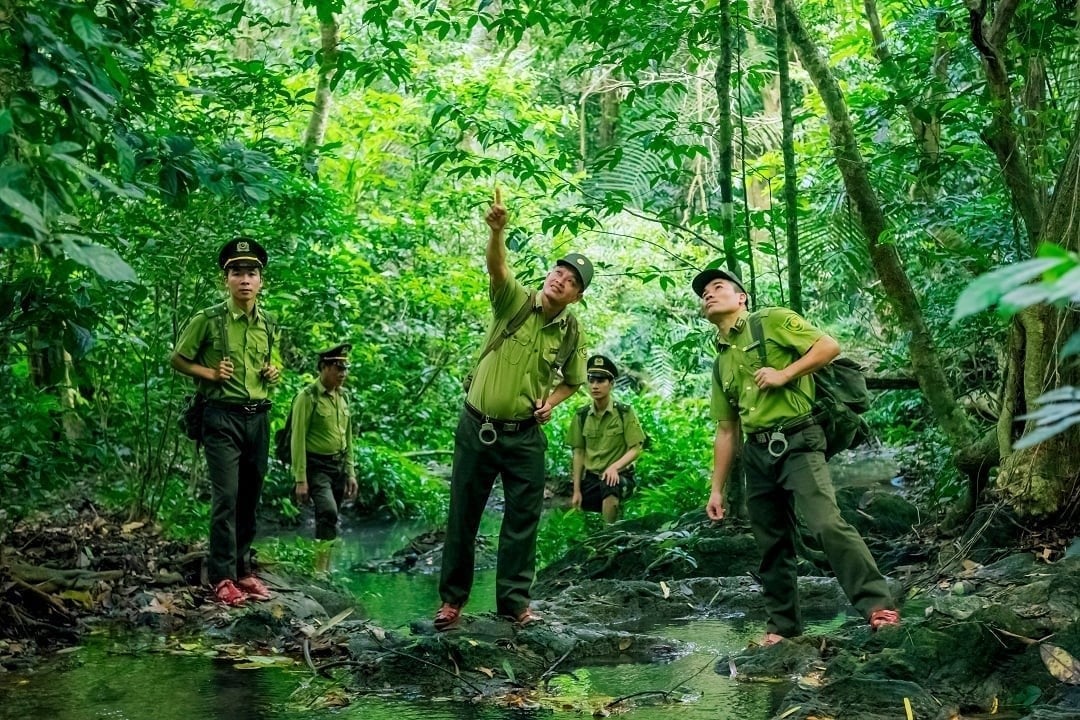November 19, 2025 | 01:59 GMT +7
November 19, 2025 | 01:59 GMT +7
Hotline: 0913.378.918
November 19, 2025 | 01:59 GMT +7
Hotline: 0913.378.918
Along the winding dirt roads of Lac Duong commune (Lam Dong province), Ko Sa Ra Dap uses an iron grip, patiently dismantling animal traps hidden in the forest. For the 1999-born member of the Trap Removal Patrol Team under the Da Nhim Watershed Protection Forest Management Board, every trap removed means saving one more wildlife.
"Some days I spend the entire day removing just one trap, but if we do not do it, even one civet or one muntjac caught in the snare would be a loss for the forest," said the young K'Ho ethnic man.

Ko Sa Ra Dap with a trap he discovered in the forest. Photo: Bao Thang.
However, trap removal is not a simple task. Many traps are set deep in the forest, dozens of kilometers away from residential areas, forcing Dap and his teammates to trek all day to reach them. At times, they encounter heavy steel-wire traps strong enough to restrain a large deer, requiring hours of effort to dismantle. Each forest patrol also carries hidden risks, from wild beasts and venomous snakes to unpredictable weather such as forest downpours.
In Da Nhim, "trap-removal knights" like Dap not only patrol the forest but also mobilize local villagers to abandon hunting and report violations when discovered. However, this small act, perhaps tedious to many people, is a signal of the truth that conservation can only be truly effective when the community takes part.
The picture of conservation in Da Nhim's mountains and forests is gradually brightening, shaped by persistent bare hands. Rather than relying solely on bans, forest rangers now combine enforcement with disseminating information and encouraging community participation. Local people no longer set traps for wildlife or exploit timber as before. Instead, they are seeking sustainable livelihoods that allow them to live in harmony with nature.
The Da Nhim story clearly demonstrates the transformation in Vietnam's forestry approach in recent years. Once viewed merely as a source of timber and land, forests are now recognized as natural heritage, serving as the foundation for sustainable development and ecological security.

Forest rangers typically patrol in groups of three to five. Photo: The Forestry and Forest Protection Department.
According to the Forestry and Forest Protection Department, Vietnam currently has more than 170 special-use forests with a total area of over 2.3 million hectares. Besides the tireless efforts of forest guardians like Dap, science and technology have helped share part of the burden.
At Bidoup–Nui Ba National Park alone, where Dap and his patrol team frequently operate, the special-use forest has recently been equipped with more than 100 camera traps to monitor and capture images of both wildlife and human activity at designated sites. The collected images enable conservationists to adjust their patrol methods and activities in line with realities, ensuring the highest effectiveness.
Vietnam's conservation network also extends to the Northern region. Cuc Phuong, the country's first national park established in 1962, marks a milestone in this journey. Spanning more than 22,000 hectares, it preserves a lowland tropical rainforest ecosystem, which is home to thousands of plant and animal species, including many endemic species.
Cuc Phuong is also home to rescue centers for primates, turtles, carnivores, and pangolins. These units specialize in saving endangered wildlife. The existence of these centers shows that conservation is not only to protect forests but also to directly rescue species on the brink of extinction. The recorded presence of yellow-cheeked gibbons and red-shanked doucs in the wild, as well as elephants, bears, and gaurs in national parks, affirms that habitats for these species are still being maintained.

Elephants are conserved at Yok Don National Park. Photo: Y Siem.
Mr. Nguyen Van Chinh, Director of Cuc Phuong National Park, believes that Vietnam’s conservation success lies in the combination of policies, community involvement, and international cooperation. "We protect forests to safeguard the lives of all species, and in doing so, we are also protecting humanity's future," he said.
According to Mr. Chinh, the next phase of conservation must be more deeply aligned with the green economy. Ecotourism models, payments for environmental services, and the carbon market should become key resources for sustaining forests. At the same time, the application of technologies such as satellite imagery, automatic camera traps, and artificial intelligence will enhance monitoring efficiency and enable early prevention of violations. "Conservation can only be sustainable when the people truly benefit from the forest and become key actors in its management," he emphasized.
In the global conservation landscape, Vietnam has been actively engaged in numerous initiatives. The National Biodiversity Strategy to 2030, with a vision to 2050, sets a clear target for the area of protected forests. At the same time, Vietnam is a signatory to the Convention on Biological Diversity and the Ramsar Convention and has endorsed the 30x30 Initiative, which aims to protect at least 30% of terrestrial and marine areas by 2030. These commitments not only bring international support but also position Vietnam as a responsible partner.
From the footsteps removing traps in Da Nhim to a conservation system stretching from North to South, Vietnam's forestry sector has come a long way. The story of forests is no longer limited to wood exploitation, forest cover maintenance, or export revenue; it has expanded to biodiversity conservation, green economy development, and international integration. This marks a major transition, reflecting the new position of Vietnam’s forestry sector in the era of sustainable development.
Translated by Thu Huyen

(VAN) Integrating agricultural extension activities with ecotourism development unlocks promising new avenues for localities boasting specific advantages in grape and apple cultivation.

(VAN) Enterprises and cooperatives accompany farmers in Tay Ninh to develop an organic seedless lime growing area, paving the way for poverty reduction.

(VAN) There were times when Pho faltered, yet his aspiration to bring the pure aroma to those who truly value clean tea kept urging him forward.

(VAN) Bich Thao Coffee Cooperative pioneered products achieving the national 5-star OCOP standard, paving the way for Son La coffee to conquer international markets.

(VAN) The Bao La bamboo-and-rattan cooperative has been producing goods integrated into value chains. As a result, its products have reached global markets.

(VAN) The training course in An Giang equips learners with emission verification methods, thus creating a basis for low-emission rice production.

(VAN) Thu Lum commune is focusing on developing medicinal plants under the forest canopy, creating sustainable livelihoods for local people, and contributing to protecting the ecological environment.